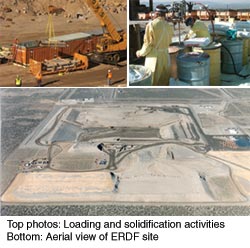


| Growth and Change at Hanford
On-Site Disposal Facility |
|
 Hanford’s Environmental Restoration Disposal Facility (ERDF)—operated by Duratek since its opening in June 1996—accepts waste from site cleanup and environmental restoration initiatives. In 2005, Bechtel Hanford Inc., prime contractor to the U.S. Department of Energy (DOE), awarded Duratek a two-year extension to its contract to operate the ERDF site. Current disposal operations at the ERDF site have grown and changed considerably since the landfill opened nine years ago. Initially, waste from remediation sites consisted of primarily soil and cobble with a disposal production rate of approximately 20–30 containers per day. Now, it is a rare event to dispose of less than 200 containers per day, not including special-handled waste and treatment operations. On August 30, 2004, the ERDF made the 5-million-ton mark for waste receipts. On February 24, 2005, 325 containers consisting of 7,296 tons of waste were disposed at the ERDF—a facility record and a truly remarkable achievement. Two new disposal cells were recently added to the site. Disposal in these cells averages over 70 trucks per day. Due to the volume of low-level radioactive soil and debris coming to the site, swing shift operations were added in March 2005. Even with two shifts, the disposal schedule still warrants the need for ERDF personnel to work on Saturdays. In addition to roll-off containers of waste, a large volume of waste requiring special handling is disposed of at the ERDF site. Structures such as ion exchange modules, transformers, and other large pieces of equipment and debris, some of which require crane and rigging, are a regular occurrence. Pipes and structures are filled in with grout or sand. Hazardous materials are macro-encapsulated to prevent leach-ability of Resource Conservation and Recovery Act (RCRA) metals. Beryllium-contaminated waste from building demolition, which requires special training and exclusion zones, is slated for disposal at ERDF in the near future. Treatment of RCRA mixed waste is also a disposal operation that occurs at the ERDF. Since March 2004, 3,627 drums of 183-H Solar Basin waste has been treated and disposed at the ERDF. New treatment operations have been requested by the customer. These operations include preparation of treatment plans and treatability experiments to support development of full-scale stabilization operations for lead and chromium contaminated waste. The ERDF site is no longer just a landfill to dispose of low-level radioactively contaminated soil. The site and its mission under Duratek operation has grown and diversified into a multi-functional, full-service disposal facility for the Hanford site. It has achieved this status safely, with zero lost time accidents since facility start-up (3,208 days), while disposing 5.6 million tons of waste materials and complying with DOE orders and federal regulations cost-effectively. |
|